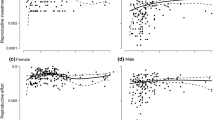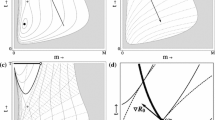Abstract
We study optimal two-sector (vegetative and reproductive) allocation models of annual plants in temporally variable environments that incorporate effects of density-dependent lifetime variability and juvenile mortality in a fitness function whose expected value is maximized. Only special cases of arithmetic and geometric mean maximizers have previously been considered in the literature, and we also allow a wider range of production functions with diminishing returns. The model predicts that the time of maturity is pushed to an earlier date as the correlation between individual lifetimes increases, and while optimal schedules are bang-bang at the extremes, the transition is mediated by schedules where vegetative growth is mixed with reproduction for a wide intermediate range. The mixed growth lasts longer when the production function is less concave allowing for better leveraging of plant size when generating seeds. Analytic estimates are obtained for the power means that interpolate between arithmetic and geometric mean and correspond to partially correlated lifetime distributions.












Similar content being viewed by others
Notes
For \(\alpha =0,\) this is replaced by \(\tau =\left( 1+\frac{1}{r}\right) \ln (1+r\tau )\), and for \(\alpha =-1\) by \(\tau =\frac{1}{r(1+r)}(1+r\tau )\ln (1+r\tau )\).
For \(\alpha =0,\) the second equation is replaced by \(r=\ln (1+r\tau )\), and for \(\alpha =-1\) by \(r(1+r)=\ln \tau \).
For \(\alpha =0,\) this simplifies to \(q(t)=\frac{1}{C-t}\).
Abbreviations
- x, y :
-
Vegetative, reproductive mass, 1.2
- \(T_0,T\) :
-
Safe, volatile period, 1.2
- L(y):
-
Fitness function, 1.1
- P(x):
-
Production function, 1.2
- \(\alpha \) :
-
Fitness index, 1.1
- \(\text {Sw}(\tau ,\xi ,y)\) :
-
Switching function, 3.1
- \(\text {Cut}(\tau ,\xi ,y)\) :
-
Cutoff function, 3.1
- \(\lambda ,\mu \) :
-
Costate variables for x, y, 3.1
- \(\xi \) :
-
Adjusted vegetative mass, 3.1
- \(\tau \) :
-
Adjusted time-to-go, 3.1
- q, r :
-
Adjusted mass ratios, 4
- \(q_c\), \(r_c\), \(\tau _c\) :
- \(t_s\) :
- \(t_m\) :
-
Time of maturity, 3.1
References
Amir S, Cohen D (1990) Optimal reproductive efforts and the timing of reproduction of annual plants in randomly varying environments. J Theor Biol 147:17–42
Argasinski K, Broom M (2013) The nest site lottery: how selectively neutral density dependent growth suppression induces frequency dependent selection. Theor Popul Biol 90:82–90
Argasinski K, Rudnicki R (2017) Nest site lottery revisited: towards a mechanistic model of population growth suppressed by the availability of nest sites. J Theor Biol 420:279–289
Argasinski K, Rudnicki R (2020) From nest site lottery to host lottery: continuous model of growth suppression driven by the availability of nest sites for newborns or hosts for parasites and its impact on the selection of life history strategies. Theor Biosci 139:171–188
Brown J, Venable D (1991) Life history evolution of seed-bank annuals in response to seed predation. Evolut Ecol 5:12–29
Bell G, Lechowicz M, Schoen D (1991) The ecology and genetics of fitness in forest plants III. J Ecol 79(3):697–713
Cohen D (1966) Optimizing reproduction in a randomly varying environment. J Theor Biol 12:19–129
Cohen D (1971) Maximizing final yield when growth is limited by time or by limiting resources. J Theor Biol 33(2):299–307
Clark C, Poulsen J, Levey D, Osenberg C (2007) Are plant populations seed limited? A critique and meta-analysis of seed addition experiments. Am Nat 170(1):128–142
De Lara M (2006) Mum, why do you keep on growing? Impacts of environmental variability on optimal growth and reproduction allocation strategies of annual plants. J Math Biol 52(5):633–666
Dempster E (1955) Maintenance of genetic heterogeneity. Quant Biol 20(1955):2–32
Denholm J (1975) Necessary condition for maximum yield in a senescing two-phase plant. J Theor Biol 52(1):251–254
Ejsmond A, Kozlowski J, Ejsmond M (2019) Probing of mortality rate by staying alive: The growth-reproduction trade-off in a spatially heterogeneous environment. Func Ecol 33:2327–2337
Engen S, Saether B (2017) r-and K-selection in fluctuating populations is determined by the evolutionary trade-off between two fitness measures: growth rate and lifetime reproductive success. Evolution 71(1):167–173
Fox G (1992) Evolutionary ecology. Ann Rev Ecol Syst 24:482–499
Frank S (2011) Natural selection I. Variable environments and uncertain returns on investment. J Evolut Biol 24:2299–2309
Frank S, Slatkin M (1990) Evolution in a variable environment. Am Nat 136:244–260
Gillespie J (1977) Natural selection for variances in offspring numbers: a new evolutionary principle. Am Nat 111:1010–1014
Goudriaan J (1979) A family of saturation type curves, especially in relation to photosynthesis. Ann Bot 43:783–785
Harper J (1977) Population biology of plants. Academic Press, London
Hui C (2006) Carrying capacity, population equilibrium, and environment’s maximal load. Ecol Modell 192(1–2):317–320
Hulme P, Benkman C (2002) Granivory. In: Herrera C, Pellmyr O (eds) Plant-animal interactions: an evolutionary approach. Blackwell Science, NY, pp 132–154
Inouye R (1980) Density-dependent germination response by seeds of desert annuals. Oecologia 46:235–238
Ioslovich I, Gutman P-O (2005) On the botanic model of plant growth with intermediate vegetative-reproductive stage. Theor Popul Biol 68:147–156
Iwasa Y, Roughgarden J (1984) Shoot/root balance of plants: optimal growth of a system with many vegetative organs. Theor Popul Biol 25(1):78–105
Johansson J, Brännström A, Metz J, Dieckmann U (2018) Twelve fundamental life histories evolving through allocation-dependent fecundity and survival. Ecol Evol 8(6):3172–3186
Kelly D, Sork V (2002) Mast seeding in perennial plants: why, how, where? Ann Rev Ecol Syst 33:427–447
King D, Roughgarden J (1982) Graded allocation between vegetative and reproductive growth for annual plants in growing seasons of random length. Theor Popul Biol 22(1):1–16
Lande R, Engen S, Saether B (2009) An evolutionary maximum principle for density-dependent population dynamics in a fluctuating environment. Philosoph Trans Royal Soc B 364:1511–1518
Lenhart S, Workman J (2007) Optimal control applied to biological models. Chapman & Hall/CRC, Boca Raton, FL
Lewontin R, Cohen D (1969) On population growth in a randomly varying environment. PNAS 62(4):1056–1060
Linhart Y (1976) Density-dependent seed germination strategies in colonizing versus non-colonizing plant species. J Ecol 64(1):375–380
MacArthur R, Wilson E (1967) The theory of island biogeography. Princeton University Press, Princeton
Mironchenko A, Kozlowski J (2014) Optimal allocation patterns and optimal seed mass of a perennial plant. J Theor Biol 354:12–24
Ooi R, Whelan J, Auld T (2006) Persistence of obligate-seeding species at the population scale: effects of fire intensity, fire patchiness and long fire-free intervals. Int J Wildland Fire 15:261–269
Perrin N, Sibly R (1993) Dynamic models of energy allocation and investment. Ann Rev Ecol Syst 24:379–410
Pianka E (1970) On \(r\)- and \(K\)-selection. Am Nat 104(940):592–597
Post D, Palkovacs E (2009) Eco-evolutionary feedbacks in community and ecosystem ecology: interactions between the ecological theatre and the evolutionary play. Philosoph Trans Royal Soc B 364:1629–1640
Reekie EG, Bazzaz FA (eds) (2005) Reproductive allocation in plants. Physiological ecology series. Academic Press, Burlington
Roff D (2008) Defining fitness in evolutionary models. J Genet 87:339–348
Seger J, Brockmann H (1987) What is bet-hedging? Oxford Surv Evolut 4:182–211
Seierstad A, Sydsaeter K (1986) Optimal control theory with economic applications. Elsevier, New York
Slatkin M (1974) Hedging one’s evolutionary bets. Nature 250:704–705
Takahashi D, Yamauchi A (2010) Optimal defense schedule of annual plants against seasonal herbivores. Am Nat 175(5):538–550
Venable D (2007) Bet hedging in a guild of desert annuals. Ecology 88(5):1086–1090
Vincent T, Pulliam H (1980) Evolution of life history strategies for an asexual annual plant model. Theor Popul Biol 17(2):215–231
Wenk E, Falster D (2015) Quantifying and understanding reproductive allocation schedules in plants. Ecol Evolut 5(23):5521–5538
Zhang H, Cheng J, Xiao Z et al (2008) Effects of seed abundance on seed scatter-hoarding of Edward’s rat ( Leopoldamys edwardsi Muridae) at the individual level. Oecologia 158:57–63
Ziolko M, Kozlowski J (1995) Some optimization models of growth in biology. IEEE Trans Autom Control 40(10):1779–1783
Acknowledgements
This work was conceived during the summer 2019 REU program at the University of Houston-Downtown and is funded by the National Science Foundation Grant 1560401. The authors are grateful to the anonymous reviewers for clarifying the relation between density dependence and fitness and many other helpful suggestions that greatly improved the paper.
Funding
All authors were supported by the National Science Foundation Grant 1560401.
Author information
Authors and Affiliations
Contributions
All authors contributed to the paper’s conception and design. The manuscript was written by SK with contributions from MT. All authors commented on previous versions of the manuscript and approved the final manuscript.
Corresponding author
Ethics declarations
Conflicts of interest
The authors do not have any conflicts of interest.
Additional information
Publisher's Note
Springer Nature remains neutral with regard to jurisdictional claims in published maps and institutional affiliations.
Rights and permissions
About this article
Cite this article
Koshkin, S., Zalles, Z., Tobin, M.F. et al. Optimal allocation in annual plants with density-dependent fitness. Theory Biosci. 140, 177–196 (2021). https://doi.org/10.1007/s12064-021-00343-9
Received:
Accepted:
Published:
Issue Date:
DOI: https://doi.org/10.1007/s12064-021-00343-9




